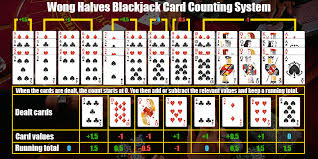
The Wong Halves card counting system was developed by Stanford Wong and was introduced in his book, Professional Blackjack, in 1975. Stanford Wong is actually an alias for John Ferguson, a well-known, professional blackjack player.
The Wong Halves is a level 3, balanced system which means it is one of the most complicated systems devised.
It values some cards at fractions of a point, so a lot more concentration is needed, and more advanced mathematical logic is required. Also, because it is a balanced system, a conversion of running count to true count is required.
The indices range from -1 to +1.5, which is why it’s a level 3 system and very difficult to learn. Just the idea of using fractional numbers, would make you think it is probably much more accurate than many other counting systems. The betting correlation (calculation of accuracy in determining player-favorable situations) for this system is 99%, so almost perfect.
Your count will start at zero and will also reset to zero after the cards are shuffled.
What else makes this system difficult is that a true count, instead of a running count is used. Fortunately, getting a true count is not all that difficult, it’s just one more step in the process.
True count is determined by dividing the running count by the estimate of the number of decks left in the shoe. A true count is designed to give the player a more accurate representation of the remaining cards and how favorable or not it is to the player.
How it Works
Each card in the deck is assigned a value of -1, -.5, 0, +1, or +1.5. The chart of values is:
| 2 | 3 | 4 | 5 | 6 | 7 | 8 | 9 | 10 | J | Q | K | A |
| +.5 | +1 | +1 | +1.5 | +1 | +.5 | 0 | -.5 | -1 | -1 | -1 | -1 | -1 |
As the cards are dealt, a running count is kept. The starting count will be zero. You will then need to convert the running count to the true count before deciding on your bet.
Once you reach the shuffle, you revert back to the starting number of zero.
In order to make it less complicated, some people multiply the values by 2, so there are no fractions. Despite doing that, it still is a complicated system to learn and use. You have to be aware by doing that, your running count and true counts will be twice as high as they should be, so you’ll have to do another round of division to get the true values for betting.
ACE TRACKING
Fortunately, keeping track of aces on the side is not part of this system because they are given a value within the system. This system is complicated enough without adding something else to track.
SIZING YOUR BETS
As usual, once you reach a positive count, you can increase your bet.
While the count remains negative, only bet the minimum or consider moving to another table if it keeps going down.
Keep your betting spreads narrow, as to not draw attention to your playing style. Play with a betting system, but not one that will have you betting extremely high when the count is high. Don’t start betting 10-20 times the table minimum because the count has become extremely positive.
Casinos understand that players will bet more if the cards seem to be “running good,” just don’t let them figure out why you know the cards are running good!
FINAL THOUGHTS
The Wong Halves system is definitely for an experienced card counter who wants an extremely accurate system. It is very hard to use, which is why it is not used a lot, but quite effective when compared with most other systems.

